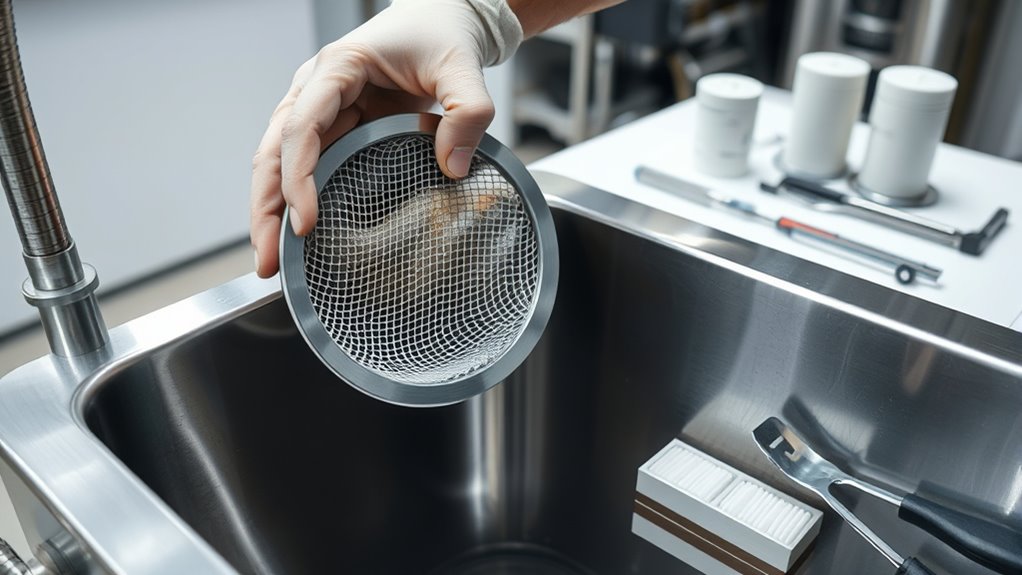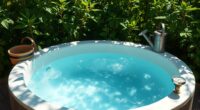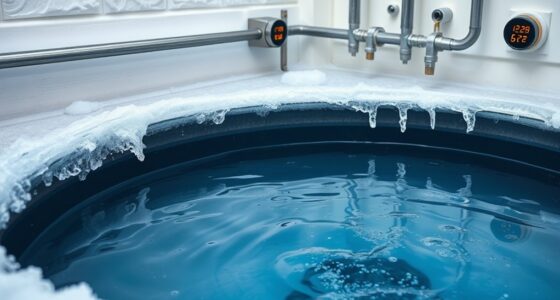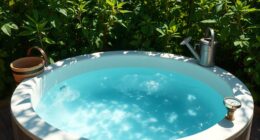To clean your cold plunge filters, remove them and rinse thoroughly with a garden hose, avoiding harsh chemicals. Soak the filters in mild vinegar periodically to break down mineral buildup. Replace filters every 3-6 months or when you notice odors, cloudiness, or reduced water flow. By maintaining proper water chemistry and inspecting filters regularly, you keep your system clean and efficient. Keep going to discover more tips for ideal filter care and system longevity.
Key Takeaways
- Remove and rinse filters thoroughly with a garden hose to eliminate debris and dirt buildup.
- Use gentle cleaning solutions or soak in mild vinegar periodically to break down mineral and organic deposits.
- Replace filters every 3-6 months, or sooner if water flow decreases or odors persist.
- Maintain proper water chemistry by balancing pH and sanitizer levels to reduce filter clogging and extend lifespan.
- Regularly inspect filters for signs of wear and clean them promptly to ensure optimal filtration performance.

Filters in cold plunge systems play a essential role in maintaining clean and safe water, guaranteeing your experience is both invigorating and hygienic. Proper filtration maintenance isn’t just about keeping the water clear; it also safeguards your health by preventing bacteria, algae, and other contaminants from thriving. Regularly inspecting and cleaning your filters is indispensable to maximize their performance and prolong their lifespan. When filters become clogged or dirty, water flow decreases, and filtration efficiency drops, making it critical to stay on top of maintenance routines.
Regular filter inspection and cleaning are essential for a safe, hygienic cold plunge experience.
To extend your filter’s lifespan, you should follow the manufacturer’s recommended cleaning schedule. Typically, this involves removing the filter and rinsing it thoroughly with a garden hose to wash away debris and particles. For filters that are reusable, avoid harsh chemicals that could degrade the filter material. Instead, use gentle cleaning solutions or soak them in a mild vinegar solution periodically to break down mineral buildup and organic matter. If your system uses replaceable filters, keep track of their age and replace them before they become too worn or clogged, which can compromise water quality.
A key aspect of filtration maintenance is understanding when to replace your filters. Most filters have a recommended lifespan, often between three to six months, depending on usage and water quality. If you notice a persistent odor, cloudiness, or a significant drop in water flow, it’s a sign that your filter has reached the end of its effective life. Ignoring these signals can lead to reduced filtration capacity, allowing impurities to circulate in the water. Regularly checking your filters and replacing them as needed ensures your cold plunge remains hygienic and safe.
Additionally, maintaining good water chemistry can extend the life of your filters. Proper chemical balance reduces the workload on your filtration system, preventing mineral buildup and algae growth that can clog filters prematurely. Consistent testing and adjusting pH levels, sanitizer levels, and alkalinity help keep your water clean and your filters functioning at their best. Remember, investing time in filtration maintenance and understanding your filter’s lifespan not only improves water quality but also saves you money by reducing the frequency of replacements. Proper filter care and maintaining a balanced water chemistry are essential for optimal system performance.
Frequently Asked Questions
How Do I Know When Filters Need Replacing?
You’ll know it’s time to replace your filters when they show signs of clogging or reduced water flow, typically after their recommended filter lifespan. Most filters need replacement every few months, depending on usage and water quality. Keep an eye on water clarity and odor—if you notice cloudiness or a strange smell, it’s a clear sign to change the filter. Regular maintenance guarantees your cold plunge stays clean and safe.
Are There Eco-Friendly Filter Options Available?
Think of your cold plunge as a garden needing gentle care; eco-friendly filters are your seeds of change. Yes, biodegradable filters and reusable filter media are available, helping you reduce waste and protect the environment. These options symbolize your commitment to sustainability, allowing you to maintain clean water without harming nature. Embrace these green choices, and your system will thrive, just like a well-tended garden in full bloom.
Can I Clean Filters Without Removing Them?
Yes, you can clean filters without removing them by using a gentle brush or vacuum to remove debris. For effective filter cleaning, follow maintenance tips like rinsing with water or using a mild cleaning solution if needed. Avoid harsh chemicals, and make sure you dry the filter thoroughly before reinstalling. Regular cleaning helps maintain water quality and prolongs your filter’s lifespan, making your cold plunge system run smoothly.
What Are the Signs of a Failing Filter?
You’ll notice your filter is failing when water clarity declines, indicating it’s not filtering effectively. Other signs include a musty odor or increased debris in the water, which suggests the filter’s lifespan is nearing its end. If you ignore these signs, your system could strain or become damaged. Regularly check your filter and replace it as needed to maintain peak performance and clear, clean water in your cold plunge system.
How Do Filter Replacements Affect Cold Plunge System Performance?
Ever wonder how filter replacements boost your cold plunge system? When you replace filters on time, you extend their lifespan and guarantee peak performance. Fresh filters improve water clarity, reduce bacteria, and maintain consistent cooling. Thinking about filter upgrade options? Upgrading can enhance filtration efficiency and prolong system life. Regular replacements prevent clogs, minimize energy use, and keep your plunge running smoothly, giving you a better, safer experience every time.
Conclusion
Regularly cleaning and replacing filters in your cold plunge system keeps the water clean and safe. Did you know that a single dirty filter can harbor up to 2.6 million bacteria? Imagine the impact on your health if those germs go unchecked. By staying on top of maintenance, you guarantee a pristine experience every time, helping you enjoy the benefits of cold therapy without worry. Keep those filters clean, and your plunge will always be ready for your next invigorating dip.









